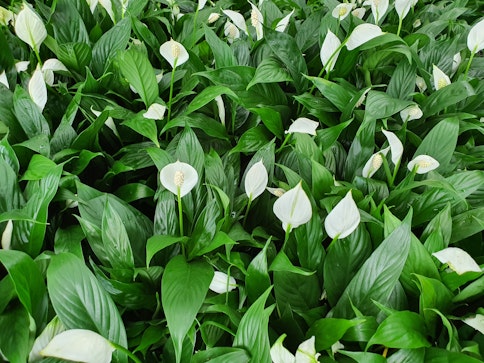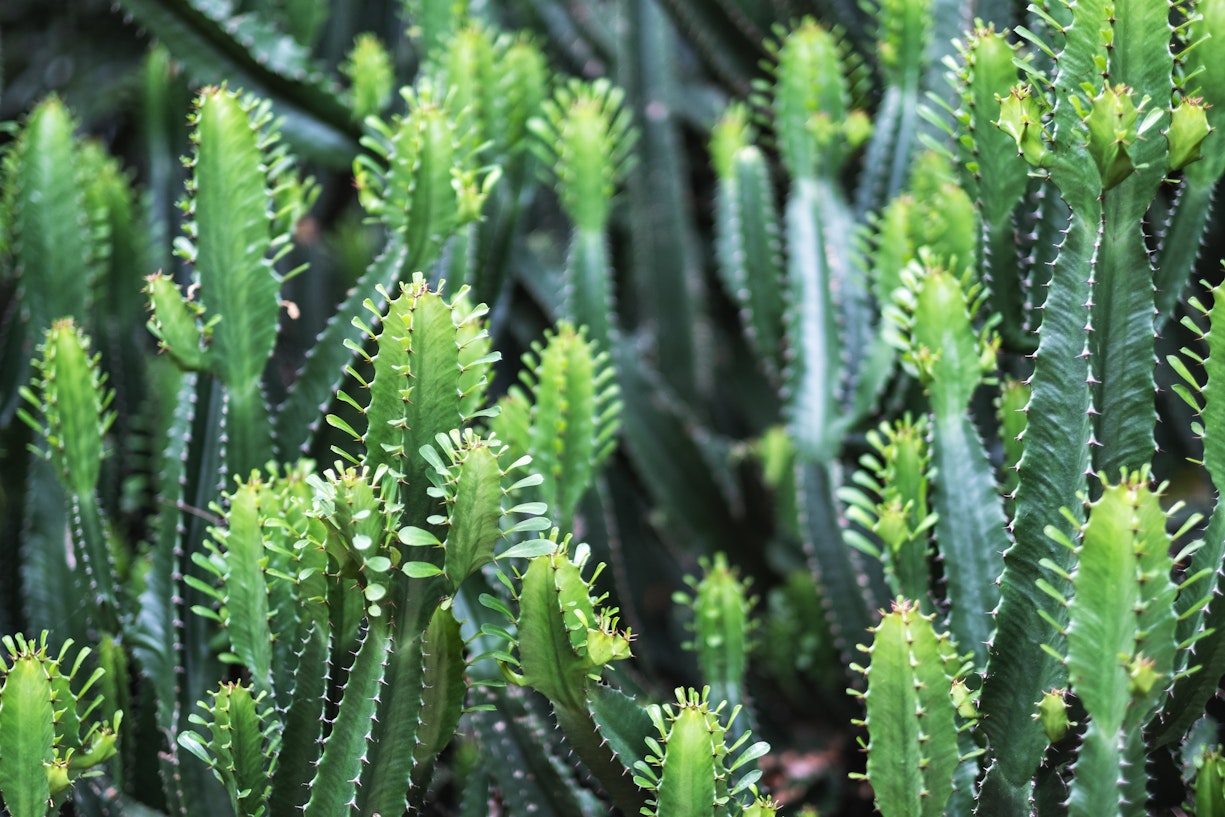
- Home
- Euphorbia: General Care

What is Euphorbia?
Euphorbia is a very unique genus of flowering plants in the Euphorbiaceae family of plants. They boast a huge amount of variety and are particularly popular with people who enjoy weird and wonderful plants. Euphorbia are mostly found in Mainland Africa and Madagascar, but there are some species native to Asia, Australia and the Americas too. Euphorbia vary from cactine succulents lined with spikes to brightly coloured leafy-things and beyond. There really is no limit to them, which makes them a great collector’s plant or just a good source of quirky plants to have in the home.
Because the genus is so varied, there is no one care guide that is sufficient in keeping all plants. For the purpose of this post, I will separate them into three groups:
- Shrubby Euphorbia: Commonly called Garden or Cushion spurges. This includes plants like E. characias or E. griffithii, that are primarily kept outdoors in the UK. They are fast growing, long blooming shrubs that typically have bundles of long-leaf rosettes.
- Succulent Euphorbia: Commonly known as ‘Milk Trees’ or ‘Desert Spurges’. This group includes plants such as E. trigona or E. tirucalli which are succulent or ‘cactus like’ in form, often growing leaves alongside their spines, for keeping inside in the UK.
- Leafy Euphorbia: Common names vary from plant to plant. These Euphorbia present in the typical stem-and-leaf form, usually with large, shapely and textured leaves that grow in a variety of greens and reds, such as E. pulcherrima (Poinsettia) and E. heterophylla (Mexican fire plant).
Shrubby Euphorbia Care:
Shrubby Euphorbia are best kept outside, due to their need for consistent direct sunlight.
Water: Shrubby Euphorbia need to be kept moderately damp. Try your best not to get them soaking wet or let them go completely dry. You may find that in the winter this will need to be done a lot less, if at all. In the summer, especially during dry spells, watering frequency will need to increase significantly to keep them healthy. If they are potted, watering more frequently will ensure they do not completely dry out.
Soil: Shrubby Euphorbia like to be planted in a well draining soil. If planted in borders or a garden plot, it is a good idea to ensure a certain amount of bio-soil or organic compost is used alongside chunky inclusions like bark or gravel to provide a balanced nutrient environment. For potted plants, use a mix with more mineral inclusions such as perlite or pumice to ensure adequate drainage.
Feeding: Euphorbias of this kind planted in appropriate soil will hardly need feeding, if ever. Rich soil or overfeeding can cause Euphorbias to misgrow, and can promote leggy foliage.
Light: Planting Euphorbias that need to be outdoors is usually an indication that they would like a certain amount of direct sun. It is best to identify your specific plant and determine how much sun or shade it needs throughout the day and plant accordingly.
Pests: Shrubby Euphorbias are generally pretty resistant to most things. Their latex sap makes them strongly resistant to larger predators like caterpillars and snails, but they still fall victim to smaller pests like mealybugs and aphids. They have further been known to suffer from minor fungal problems like powdery mildew, root-rot (in wet soils) and rust-fungus.
Shrubby Euphorbia species to check out:
Euphorbia characias
Euphorbia griffithii
Euphorbia wulfenii
Euphorbia purpurea
Euphorbia wallichii
Euphorbia amygdaloides
Succulent Euphorbia Care:
Succulent Euphorbias originate mostly from the African desert. As such, they are unable to stand the fluctuating temperatures and background humidity of the UK, so must be kept inside.
Water: Water these Euphorbias very sparingly, treat them as you would a cactus, allowing them to dry out completely between waterings. Overwatering will cause their roots to rot very quickly. In the winter, it may be best to water them as little as once a month, if that.
Soil: Succulent Euphorbias prefer to be potted in a stony or chunky mix with very little water retention. Specialist cactus and succulent soil, with perlite, sand or gravel inclusions would be an ideal mix, and would add weight to them, avoiding any problems with their centre of gravity causing them to topple over.
Feeding: Feeding succulent euphorbias sparingly with a twice-diluted nitrogen rich fertilizer is ideal. Commercially, this is sold as ‘succulent fertiliser’ and is best to use during periods of active growth in the summer months, every third or fourth watering.
Light: Being from the african desert, they are used to a certain amount of sun exposure. Bright light is best, a windowsill or sunny spot that sees the sky between 4 or 6 hours a day in the summer will help them to thrive.
Pests: Succulent plants generally don't suffer from thrip or aphid infestations, but are prone to the occasional scale or mealybug infestation. Check for warning signs and treat accordingly.
Things to look out for:
Leaking sap: Euphorbia have a latex based sap that is very white and quite dense, so a small amount of tissue damage can cause the plant to leak at what seems like an alarming rate. The sap is designed to help the plant heal, and it is best to leave it to callus and dry by itself, then wipe off the dried sap after with a lukewarm, wet cloth.
Succulent Euphorbia species to check out:
Euphorbia trigona
Euphorbia bosseri
Euphorbia tirucalli
Euphorbia milii
Euphobia lactea
Euphorbia obesa
Leafy Euphorbia Care:
Leafy Euphorbias are a small complex of Euphorbias that are native to Mexican sub-tropical and tropical biomes. As such, they are unable to stand the fluctuating temperatures of the UK, so must be kept inside.
Water: Water sparingly, allowing the top few inches of soil to dry out before topping up again. You will find that in the winter months this is not as frequently necessary as in the summer. These plants are not particularly drought tolerant, nor can they handle being in sodden soil so maintaining a good water balance is essential.
Soil: Plant leafy Euphorbias in a well draining soil that contains a good amount of chunkiness. A coco coir, perlite and pine bark mix would be an ideal balance of grain sizes and water management.
Feeding: Euphorbias of all kinds do not need much feeding. Feed leafy Euphorbias in the summer using a nitrogen rich fertilizer. When diluting, use half the amount of fertiliser that is recommended to ensure you do not overfeed.
Light: Place your leafy Euphorbias in a bright-indirect spot, where the sun won’t scorch their leaves. Some morning or evening sun in the summer months is ideal, but the heat and brightness of the midday sun would likely cause damage very quickly.
Pests: Leafy Euphorbias fall victim to aphids, thrips and mealybugs, with them having softer leaves than their previously mentioned, hardier cousins. Keep an eye out for signs of pests and if found, segregate and treat accordingly.
Things to look out for:
Draughts: These more delicate Euphorbias will dry out and suffer very quickly if exposed to any airflow such as central heating, fans, draughty doors or windows. Keep your plant in a spot with a consistent air temperament.
Leaf dropping: These delicate plants will drop leaves quickly at the first sign of difficulty. If leaf dropping is significant (more than one or two older leaves) or new growth is dropping off, inspect the plants roots, soil, light levels, check for pests and ensure there is no draught.
Photoperiodism: The reason these types of Euphorbia are so popular is due to their ability to change colour in the winter. In periods of long darkness (14 - 16 hours) after sun exposure in the day, the most exposed leaves turn red by a process known as photoperiodism. Such a phenomenon is not harmful to the plant.
Leafy Euphorbia species to check out:
A large portion of the available plants of this type are poinsettias, which are a largely cultivated and extremely popular winter plant. Poinsettia varieties are all cultivars of E. pulcherrima and are listed below.
Euphorbia pulcherrima cv ‘Grande Italia’ (red)
Euphorbia pulcherrima cv ‘Alaska White’ (White)
Euphorbia pulcherrima cv ‘White Wonder’ (White)
Euphorbia pulcherrima cv ‘Christmas Beauty Pink’ (Pink)
Euphorbia pulcherrima cv ‘Sky Star’ (Variegated)
Euphorbia heterophylla
Jonathan Davies
Jonny has worked at Root since May 2023. His love for plants was inherited initially from his grandparents and parents, but really took off once he moved into his own place, where he started picking up small plants and was fascinated by watching how they grow and change over time. Jonny has a degree in Archaeology and Classics from the University of Sheffield, and a masters in Egyptology from Swansea University, where he primarily focused on garden culture in the ancient world, which he has managed to extend to a PhD thesis in the University of Liverpool, where he has been able to combine his love for plants with his love for ancient language and culture. Jonny loves being in the natural spaces around North Wales and Cheshire where he used to go growing up, and often spends hours examining the plants and trees, and kicking up the leaf litter searching for mushrooms and insects. He is fascinated most by plant biology, taxonomy and learning about ecosystems and interactions between plants and their environmental counterparts, and enjoys tending to his varied array of houseplants, and ongoing ‘plant projects’, such as growing plants from seeds and creating living epiphyte displays. Aside from his green thumb, his other interests include: art, reading, listening to and playing music in the company of his cats, Spooky and Boo.
More by Jonathan DaviesRelated Articles
View all articles




